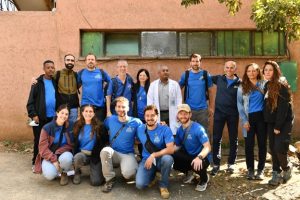
Studies had proved that maize is the cradle land of Mexico. It gradually rippled to other parts of the world.
Maize was introduced to Ethiopia in 16th century by the Portuguese. Later it was being imported from South Africa and Kenya. This shows that Maize is exogenous to Ethiopia.
Maize has the highest reproductive capacity in that a seed can multiply itself over to 500 seeds.
In Ethiopia, maize grows over 2 million hectares of land and annually 8 million tons of maize is produced to support the livelihood of 11 million people.
Nevertheless, the crop is highly vulnerable to diseases. To overcome the challenges, in addition to spraying insecticides, providing improved seeds through biotechnological means is taken as way out.
Dr Letta Tulu works in the National Biotechnology Research Center located in Holeta west of Addis Abeba. He is a senior biotechnology researcher.
As to him, currently the project known as Tilla which is supported by partners is engaged in research and experiment to produce a new type of maize seed which has a capacity to resist drought and diseases.
The imported technology has no a royalty fee obligation. The improved seed will be provided to the local licensed seed companies for reproduction. And in due time they will be provided with technical support.
When the seed is reproduced its cleanliness will be checked and proved— whether its gene has 99 percent drought and diseases resisting characters.
It should not be contaminated. After the final phase and the new breed seed trial experiment, it will be disseminated to small scale farmers based on the ongoing distribution .Local private and public companies see to the distribution. Farmers are required only to pay the seed price not the research expense.
According to Letta ,the drought-prone maize growing areas are identified and areas from the eastern up to the north are highly vulnerable to drought and disease. Hence, the technology targets these areas. In contrast, the south and south western part of the country have sufficient rainfall and have high potential for crop production.
Nevertheless, all areas are vulnerable to insect-borne diseases. For example, the traditionally known as “temch” insect affects both the low and highland parts of the country.
According to Letta, producing new gene which resists drought and diseases cannot be taken as solution by itself to alleviate the problems, other agronomic factors such as soil type, precipitation and the availability of water and extension service provides to farmers also play crucial roles.
In addition the utilization of inputs including fertilizer and herb and pesticides is essential.
Unlike the current practice which is raising crop productivity through expanding farmland areas exacerbates devastation of the environment due to the clearance of vegetation cover, the hybrid seed enables to raise productivity in small plot.
According to the Commission for Environment, Forest and Climate Change recent document, a massive 60% expansion of cultivated land at the expense of clearing forests, rangelands and wetlands, which have, respectively shown 35, 59 and 85 percent reduction in area from 1984 to 2016. These changes in land use and land cover will have severe adverse economic, social and environmental implications. And the situation is continuing unabated.
Hence, utilizing new biotechnology seed output helps not only to raise productivity but also step up environmental protection efforts. Moreover it reduces insecticides spraying practice, which threatens environmental health.
About 13 million smallholder farmers account for the 90 percent of agricultural Growth Domestic Production and nearly 55 percent of smallholder food producers operate on one hectare or less. Hence application of technology in this regard is timely which can boost productivity.
With regard to the nutritive value of maize, Letta said that it is a source of carbohydrate, 9 to 10 percent protein content and has balanced amino acid. Nevertheless, under five children and breast feeding mothers should consume maize with additional cereals. But if they not do so, their health might be compromised.
Understanding the shortage of the protein content of the maize, recently, researchers have come up with new seed which has 10 percent of amino acid content similar to milk as an alternative crop and introduced to farmers. This expected to fill the nutritional gap.
It is also understood that to raise productivity, previously five species of maize is introduced to farmers and planted.
Currently, in the best productive areas, farmers who use better farming methods and utilize selected seeds produce 60 quaintal maize per hectare. In the research center, it is proved to produce from 100 to 150 quaint per hectare. This indicates that if research work continued thoroughly the amount could surpass the current rate. By now the average production per hectare has risen from 35 quaintal per hectare which was 17 in the 1990s.
Maize is widely consumed in the country. But according to the Ethiopian agricultural Transformation Institute, drought, increased population pressure, high farm input costs, and extreme poverty force smallholder farmers in drought-prone areas to implement low input farming systems. Resource-poor farmers have limited access to irrigation. This prohibits them not to unleash their potential.
These necessitates paying attention to supporting farmers to get access to credit and farming technologies so that enables to scale up the provision of drought-and-disease -resistant seeds in all parts of the country.
The Ethiopian Herald Sunday Edition September 22/2019
BY ABEBE WOLDE GIORGIS





